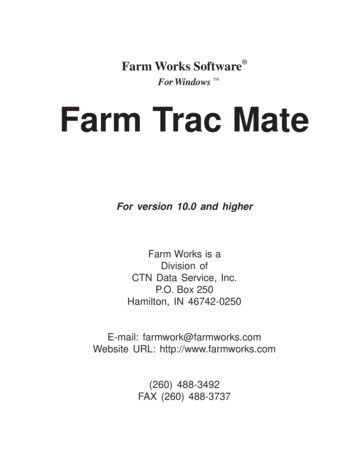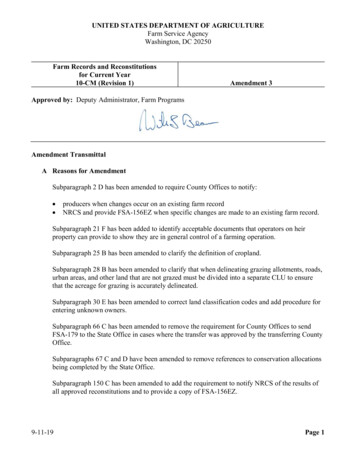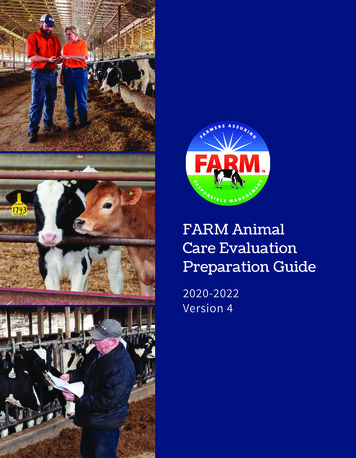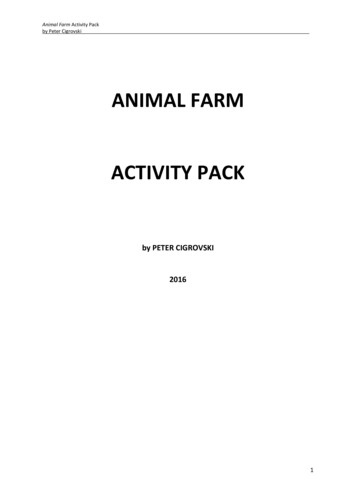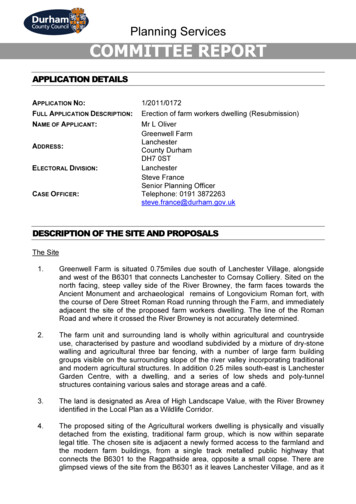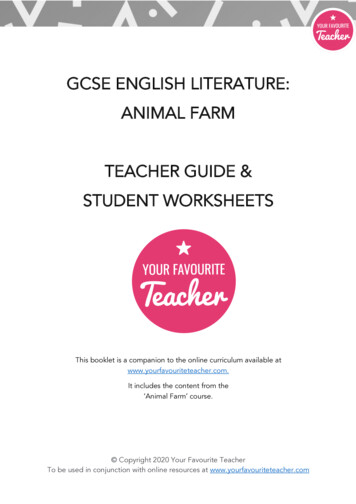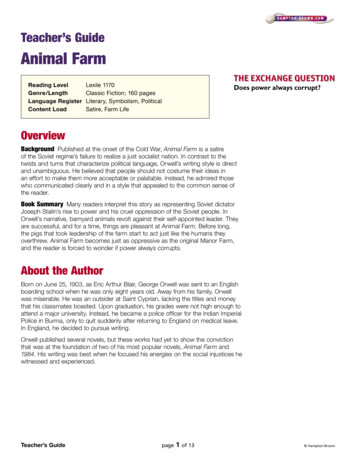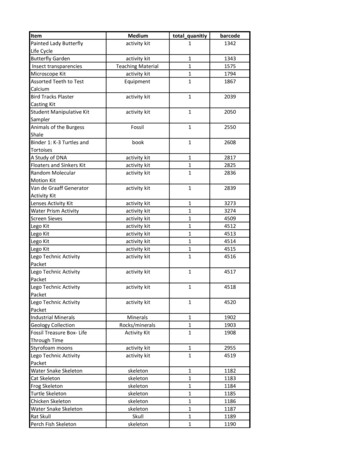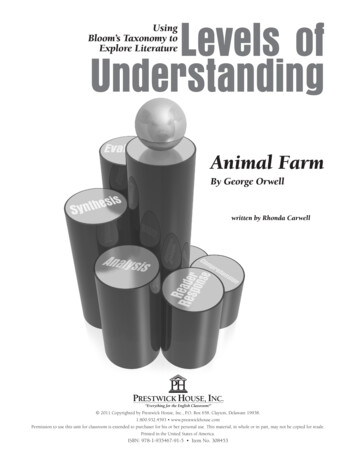
Transcription
Levels ofUnderstandingLevels of Understanding: Animal Farm IntroductionUsingBloom’s Taxonomy toExplore LiteratureAnimal FarmBy George Orwellwritten by Rhonda Carwell 2011 Copyrighted by Prestwick House, Inc., P.O. Box 658, Clayton, Delaware 19938.1.800.932.4593 www.prestwickhouse.comPermission to use this unit for classroom is extended to purchaser for his or her personal use. This material, in whole or in part, may not be copied for resale.Printed in the United States of America.ISBN: 978-1-935467-91-5 Item No. 308453
Levels of Understanding: Animal Farm Introduction
Levelsof Understanding:AnimalFarmLevelsof Understanding:Animal Farm IntroductionTable of ContentsIntroduction to Levels of Understanding . 5How to Use this Unit. 7Introduction to Animal Farm. 9Author Biography. 9Publication History of Animal Farm. 9Genre. 10Allegorical Correlations in Animal Farm. 11Works Consulted. 15Teacher’s GuideChapter 1. 16Chapter 2. 20Chapter 3. 24Chapter 4. 27Chapter 5. 31Chapter 6. 34Chapter 7. 36Chapter 8. 40Chapter 9. 43Chapter 10. 46Writing Prompts. 50Student WorksheetsChapter 1. 51Chapter 2. 57Chapter 3. 63Chapter 4. 68Chapter 5. 73Chapter 6. 77Chapter 7. 80Chapter 8. 85Chapter 9. 89Chapter 10. 93Levels of Understanding: Animal Farm Copyright 2011, Prestwick House, Inc.3
Levels of Understanding: Animal Farm Introduction4Levels of Understanding: Animal Farm Copyright 2011, Prestwick House, Inc.
Levels of Understanding: Animal Farm IntroductionIntroduction to Levels of UnderstandingFor many students,studying literature is like being lost in an alien universe, filled with hiddensymbols, structures, and meanings that only a scholar can uncover. Without a teacher’s direction, students lack the skills and confidence to evaluate a work of literature on their own, andinstead, will frequently turn to resources such as the Internet for guidance. As a result, they assumeanother writer’s views instead of developing their own.Levels of Understanding breaks down complex questions students will encounter into smaller parts,showing the steps a critical reader should take in order to develop a sound evaluation of a text. Eachsection of the guide contains five types of questions representative of Bloom’s learning domains—starting with the most basic and foundational skill, knowledge and comprehension, andgradually building to the highest skill, evaluation. All the way, reluctant students areprovided with the scaffolding they need to advance from one level of understanding tothe next.The five types of questions, again, representative of Blooms domains, are as follows: C omprehension—will ask the most basic questions to ascertain the students’fundamental understanding of the text: plot facts, character identification, etc. R eader Response—will ask the students to “respond” to the text by relating it topersonal experience or by presenting an opinion on a character or event. A nalysis—will require students to study how various techniques and literary ortheatrical devices (diction, symbolism, imagery, metaphors, asides, soliloquiesetc.) function in the text. Analysis questions do not ask the student to merelyidentify or define a literary, theatrical, or rhetorical device. S ynthesis—will bridge the gap between the analysis and evaluation questions,requiring students to look at other scenes in the text and draw conclusionsabout themes, motifs, or a writer’s style. Often, a synthesis questionwill require the student to draw on prior knowledge—what has beenlearned in class or through research—and/or information from sourcesother than the literary title being studied in order to arrive at a satisfactory answer. E valuation—will ask the student to make a qualitative judgmenton the text and determine whether a particular aspect of it is effective or ineffective.Other books may list Bloom’s taxonomy, define the terms, and offer a generalexample or two. Levels of Understanding, however, provides the teacher with thetitle-specific questions to allow you to effectively bring Bloom into your classroom.In addition, unlike other available products that claim to address Bloom’s “higher order thinkingskills,” Levels of Understanding does not teach students how to answer questions about a particulartext, but instead, helps them develop skills to evaluate literature critically and without guidance.These are skills that will not only help students prepare for standardized tests like the AdvancedPlacement Language and Literature exams, the SATs, and the ACTs, but will also give students theself-assurance to develop and articulate a personal view—a skill that will be highly advantageous tothem in college.This product, however, is not geared toward upper-level students only, but is a versatile guide thatcan be used for students of all ability levels—remedial through honors. The teacher may customizethe product to fit the class’s objectives and goals, determining which questions the students will answer. Additionally, the guide is entirely reproducible, and each major division begins on a new page,so you may use Levels of Understanding for the whole work of literature or only a specific section. Levels of Understanding: Animal Farm Copyright 2011, Prestwick House, Inc.5
Levels of Understanding: Animal Farm Introduction6Levels of Understanding: Animal Farm Copyright 2011, Prestwick House, Inc.
Levelsof Understanding:AnimalFarmFarm HowTo Use This UnitLevelsof Understanding:Animal IntroductionHow to Use this UnitELevels of Understanding: Using Bloom’s Taxonomy to Explore Literature unit is intended to be adeep and rich component of your literature program, whether your goal is to prepare your students for a large-scale assessment like the AP Literature exam or to challenge your students to readcarefully and to think deeply about what they have read.The questions in this guide are designed to be flexible and meet your needs. They can be used asach homework questions when students read the text independently. in-class reading check questions and “bell-ringer” journal entries. class discussion questions and prompts. focus questions for pre-writing and essay planning. review and study questions for assessment.While the Teacher’s Guide contains an answer key, you will find that the higher-order questions(especially synthesis and evaluation) have model answers that represent more than one possibleresponse. It would be inappropriate to penalize a student whose well-reasoned and supportableanswer did not match the “correct” answer in the guide.For this reason, we strongly recommend that you view the questions inthis guide as learning activities and not as assessment activities.Many of your students are likely to find the higher domains newand perhaps intimidating. Others might be alarmed at having tosupport their reader-response reactions and their evaluationswith an accurate comprehension of the text. The questionsin this guide should act as both scaffolding and safety net,guiding your students through a new reading and thinking process and allowing them to practice without fear of“failure.”The writing prompts, however, provide richassessment and evaluation opportunities. Everyprompt is designed to invite your students tooperate in one of the higher order domains, thusgiving students the opportunity to demonstratetheir ability, and giving you the opportunity toevaluate their progress.Whether you use Levels of Understanding: UsingBloom’s Taxonomy to Explore Literature as the core ofyour literature curriculum or as a supplement, theguide and writing prompts are designed to help yourstudents attain a deep understanding of the works theyread. Ideally, they will gain the type of understandingdemanded by Advanced Placement, International Baccalaureate, and most state standards, including the Common Core State Standards of the Council of Chief State SchoolOfficers and the National Governors Association. Levels of Understanding: Animal Farm Copyright 2011, Prestwick House, Inc.7
Levels of Understanding: Animal Farm Introduction8Levels of Understanding: Animal Farm Copyright 2011, Prestwick House, Inc.
Levels of Understanding: Animal Farm IntroductionIntroduction to Animal FarmAuthor Biography“Who controls the past controls the future. Whocontrols the present controls the past.”– George Orwell, 1984The work Eric Blair, who achieved literary fame underthe nom de plume George Orwell, is characterized bythe wit and cleverness with which he attacks social injusticeand the dangers of all forms of totalitarian government.Orwell was born into what he described as a “lower uppermiddle class family.” He was an indifferent student, but hisparents were fiercely determined to see their son educated.He remained in school until he was to enter University.Lacking the money to continue his formal education, Orwellused some family connections and joined the Indian Imperial Police. While serving as an officer, Orwell began to seethe ill effects of colonialism on indigenous peoples. Hisideas about people’s right to govern themselves began toform. After a serious illness, Orwell resigned from the policeand declared his intent to become a writer. Back in England,he went on “exploratory expeditions,” during which he witnessed the squalid conditions of the poor in London.He began to achieve a reputation as a writer while alsoteaching at a boys school, and later, at college. Another illness ended his academic career, and he worked in a bookstore where he continued his examination of the social andeconomic conditions of workers in England.Orwell followed the events of the Spanish Civil War closely, eventually deciding that he needed to fight on the Republican side of the Revolution. While in Spain, he alignedhimself with the Workers Party for Marxist Unification tosupport the fight against fascism. Orwell did see some actualfighting in his military service in Spain but was shot in thethroat and forced to resign. Eventually, pro-Soviet communists in Spain declared POUM a Trotskyist organization,opposed to the ideas of Communism and Socialism. Manyof the organization’s leaders, including Orwell, were forcedinto hiding. He wrote Animal Farm between 1943 and 1944,remembering the Stalin-like Communist purges he hadescaped in Spain.Orwell was an admitted socialist; he fought in Spain forthe socialist cause. Unlike many socialists, however, whenthe horrors of Stalin’s reign in Russia came to light, he didnot abandon Socialism but the Soviet Union. ConsideringLenin and Stalin to be mere dictators, he began to writeand speak against totalitarianism. His views eventuallydeveloped into an anarchistic theory, believing that allgovernment was evil and that the punishments for crimenearly always did more harm than the crime itself.As a writer, Orwell recognized the power of his work stating, “For some years past I have managed to make the capitalist class pay me several pounds a week for writing booksagainst capitalism. But I do not delude myself that this state ofaffairs is going to last forever . the only regime, which in thelong run, will dare to permit freedom of speech is a socialistregime. If Fascism triumphs, I am finished as a writer—thatis to say, finished in my only effective capacity. That of itselfwould be sufficient reason for joining a Socialist party.”In writing Animal Farm, Orwell did not intend to parodythe Communist Revolution in Russia or to warn his worldagainst the dangers of Socialism or Communism. Instead,it was his intent to expose the dangers of absolute powerand the dangerous effects of ignorance and absolute trustin those who make the rules.Ultimately, he is warning against the dangers of not questioning the government in power. Publication History of Animal FarmWWorld War was raging in Europe,Orwell found it impossible to find a publisher forthe book he had titled Animal Farm: A Fairy Story becauseit was feared the book’s publication would endanger thetenuous alliance between Britain and the United States andthe Soviet Union. Because the Soviet Union was one of theallies fighting against Nazi Germany anti-Soviet literaturewas essentially taboo in every publishing house Orwellapproached. This included his regular publisher, Gollancz.Faber and Faber, on whose board the poet T. S. Eliot sat,also rejected it.In a July 13, 1944 letter to Orwell, Eliot praised the novelhile the secondas a “distinguished piece of writing” that was “very skillfully handled.” However, Eliot continued, he and the otherdirectors had “no conviction” that the view of Communismespoused in Animal Farm was “the right point of view fromwhich to criticize the political situation at the present time.”In other words, Eliot continued, the directors did not havethe “conviction that this is the thing that needs saying at thismoment.” Expressing his own disagreement with Orwell’s“Trotskyite” view, Eliot argued, “your pigs are the bestqualified to run the farm—in fact, there couldn’t have been anAnimal Farm at all without them: so that what was needed was not more Communism but more public-spirited pigs.”Levels of Understanding: Animal Farm Copyright 2011, Prestwick House, Inc.9
Levels of Understanding: Animal Farm IntroductionEven the British Ministry of Information became involved in blocking the novel’s publication.In an essay entitled “Freedom of the Press,” originallywritten to be a preface to the first published edition ofAnimal Farm, Orwell relates his experience with one unnamed publisher that initially accepted the novel and thenrejected it on the urging of someone in the British Ministryof Information. He quotes a letter from that publisher:I mentioned the reaction I had had from an importantofficial in the Ministry of Information with regard toAnimal Farm. I must confess that this expression ofopinion has given me seriously to think . I can seenow that it might be regarded as something which itwas highly ill-advised to publish at the present time.If the fable were addressed generally to dictatorsand dictatorships at large then publication would beall right, but the fable does follow, as I see now, socompletely the progress of the Russian Soviets andtheir two dictators, that it can apply only to Russia,to the exclusion of the other dictatorships. Anotherthing: it would be less offensive if the predominantcaste in the fable were not pigs. I think the choice ofpigs as the ruling caste will no doubt give offence tomany people, and particularly to anyone who is a bittouchy, as undoubtedly the Russians are.The person who is believed to have been the “importantofficial” alluded to in this letter was later found to be aSoviet spy. Animal Farm was finally published in August of1945 and met with immediate and lasting success. GenreAnimal Farm is a fable, an allegorical tale that usesanthropomorphized animals to teach a moral lesson. Perhaps the best known western fables are containedin Aesop’s Fables, attributed to Aesop, a supposed slave inancient Greece. Most American children grow up learning one or more of these fables that have been reproduced,reinterpreted, and recast in countless children’s book,cartoons, and movies: The Ant and the Grasshopper tells the story of thegrasshopper who plays all summer while the ants storefood. He comes to regret his lack of prudence with thearrival of winter. The Lion and the Mouse involves a mouse who gnawsthrough ropes in order to free a lion who had earlierspared his life. The Wind and the Sun is a tale in which the two wagerwho can more quickly strip a traveler of his cloak. Theharder the wind tries to blow off the cloak, the moretightly the traveler clutches it to himself; the warmthof the shining sun, however, causes the traveler toremove the cloak voluntarily. The Fox and the Grapes: in which a fox determinesthat a bunch of grapes too high off the ground for himto eat must be sour anyway.10All of these stories teach lessons about industry versuslaziness, appreciating the contributions of every member ofsociety, the power of persuasion over force, the tendency todenigrate that which we cannot have, and so on.The moral lesson of Animal Farm clearly has to do withthe dangers of placing one’s full trust and investing complete authority in a single entity, a totalitarian government.The less-intelligent animals, while fully adopting the principles of animalism, naively believe that those whom theyallow to rule them will truly act for the public benefit andnot in their own self-interest. Of course, the selfish pigsserve only their own ends and become every bit as oppressive as the former regime of Farmer Jones.One benefit of the fable is that one can ostensibly hidethe true meaning of the story behind the allegory. As Orwell himself found with his difficulty in securing publication for this novel, the subject he was addressing—and theview he was proposing—were considered too dangerous todeal with openly. Taken literally, however, as a story aboutanimals who take over a farm, the feared responses to thenovel seem silly.Part of Orwell’s problem with publication, however, wasnot just the moral of the fable, but the fact that he emphasized the allegorical elements by establishing a clearcorrelation between the characters and events of AnimalFarm and persons and events in the Russian Revolution.Thus, while Orwell could protest that the novel criticizedtotalitarianism in general, it was apparent that his truetarget was Soviet totalitarianism. Levels of Understanding: Animal Farm Copyright 2011, Prestwick House, Inc.
Levels of Understanding: Animal Farm IntroductionAllegorical Correlations in Animal FarmThose who have some knowledge of the persons andevents of the Russian Communist Revolution are best ableto see the correspondence between this specific historicalevent and Orwell’s novel. The following timeline andchart are provided to help you appreciate the significantcorrelation between the two—the correlation that hinderedthe publication of the novel for more than a year.Russian Revolution—A Brief Outline1848: Karl Marx writes his Communist Manifesto1894: Tsar Alexander III of Russia dies; Nicholas IIassumes the throne at the age of 26. His temperament andupbringing make him uniquely unprepared for his duties.1895: Vladimir Lenin, a lawyer with strong Socialistconvictions is arrested for his planning of and participationin a number of strikes and proto-revolutionary activities.1897: Lenin is sentenced to a three-year exile in Siberia.1898: Several small Russian socialist/Marxist groupsunite into the Russian Socialist Democratic Labor Party.Nineteen-year-old Leon Trotsky abandons his study ofmathematics to work toward a workers’ rebellion in Russia.1901 – 1905: Persecution of Jews intensifies, resulting inan order for all Jews to convert to the Russian Orthodoxreligion or be expelled from Russia. The advent of theindustrial revolution creates a new class of urban poorwithout even the means of growing their own food. Inaddition to the Russian Socialist Democratic Labor Party, thepopulist Socialist-Revolutionary Party forms. The RussianSocialist Democratic Labor Party eventually spits into theBolshevik and Menshevik parties.A young Joseph Stalin joins the Bolsheviks and becomesa full-time operative, inciting strikes and organizingparamilitary units. He is exiled numerous times to Siberiabut always escapes.1904: Russo-Japanese war begins. Tsar Nicholas II involveshimself deeply in war efforts, ignoring the state of affairs inthe capital.1905:January 22: Bloody Sunday: Hungry and impoverishedworkers, led by Russian Orthodox priest George Gapon,peaceably approach the Winter Palace in St. Petersburg;with a petition for the Tsar. Demonstrators are fired on bypolice, 100 workers are killed, and the demonstration’sleaders are seized. The unrest continues, as the peoplebelieve the Tsar has abandoned them.August: Unrest continues; strikes continue; TsarNicholas II creates what is believed to be a consultativeassembly of the people (Duma); revolutionaries criticizeit for being too weak.August: Russo-Japanese war ends in Russian defeat.October: Nicholas II issues the “October Manifesto,”granting more civil liberties and giving more power tothe Duma. He refuses, however, to concede rights ofautocracy.December: Moscow Uprising: rebels try to take the citythrough armed struggle but it fails; Tsar issues ordersfor severe military reprisals to crush dissent.1906:April: A new constitution, Fundamental Laws of Russia,is enacted on April 23.July: The first Duma under the new constitution isdeemed too radical by Tsar and disbanded.September: Government orders use of any means tomaintain public order and political parties in Russiaare threatened by the Tsar.1907:June: Second Duma also fails; still deemed too radical.November: Third Duma simply does as it is told by Tsar.People turn from democratic principles to favor radicalchange.Lenin is exiled; flees to Finland and then Switzerland.Trotsky is exiled to Siberia; also flees the country.1912: Fourth Duma is elected. Soon the government andDuma are in dissent.1912 – 1916: Public outcry arises for the removal ofRasputin from the court; however, the mystic and healer’sinfluence on the imperial family continues.1914: Germany declares war on Russia following Russia’smobilization to defend its borders with Austria.August – November: World War I is characterizedby heavy losses and defeats, shortages of food andammunition.Levels of Understanding: Animal Farm Copyright 2011, Prestwick House, Inc.11
Levels of Understanding: Animal Farm IntroductionAugust: St. Petersburg is renamed Petrograd tosound more Russian rather than German and bolsterpatriotism.1916: War effort continues to be characterized byshortages and poor leadership; soldiers desert; Tsar andgovernment blamed for incompetenceDecember: Rasputin is murdered; Tsar is warned thatthe military will not defend him against a revolution.1917: Labor strikes continue across Russia; Duma reconvenesand attacks the government about food shortages.February: International Women’s Day: demonstrators(mostly women and striking workers) are joined bybread demonstrators. Revolutionary banners andslogans appear.The February Revolution: Strikes and violence inPetrograd increase. Nicholas orders the use of militaryforce, but the troops eventually desert, siding withthe rioters. The Duma refuses to disband and forms aProvisional Committee to govern. The Tsar is unableto return to Petrograd.March: Tsar Nicholas II is forced to abdicate thethrone for himself and his son. The imperial familyis imprisoned. The effectiveness of the ProvisionalGovernment is hampered by war.April: Lenin returns to Russia and dominates theBolshevik party.Resistance to Bolshevik rule erupts in civil war.December: Cheka (All Russian ExtraordinaryCommission for the Struggle Against Counter-Revolutionand Sabotage) is created to squash all resistance toBolshevik rule; it eventually claims the right to arrest andexecute people without question.Leon Trotsky emerges as second only to Lenin in theBolshevik party.1918:January: Russia is declared a Soviet Republic. Previousruling classes are prohibited from holding power. All“power” is given to workers and soldiersFebruary: Red Army founded to counter antiBolshevik forces. Stalin uses fear and intimidationagainst rebelling peasants and supporters of the White(anti-Bolshevik) Army.May: On direct orders from Lenin, the Imperial family,the Romanovs, are assassinated in the basement of thehouse in which they were imprisoned in Yekaterinburg.1922: Lenin suffers a stroke, forcing him into semiretirement; tries to warn government of the need forStalin’s removal but his testament remains a secret.1924: Lenin dies; Stalin assumes more power; denouncesTrotsky and his ideas to oppose his rule.1925: Trotsky forced to resign from military posts.May: Trotsky returns from exile.June: First All-Russian Congress of Soviets is deeplydivided; parties involved include Menshevik, SR, andBolsheviks (pro-peace).July: Trotsky merges his supporters with Bolsheviks;revolt against the Provisional Government unsuccessful;Trotsky arrested, Lenin escapes to Finland.September: Lenin and Trotsky are released fromprison; Bolsheviks have majority in ruling committeesand elect Trotsky chairman.October/November: October Revolution: Bolshevikswrest control from the Provisional Government. Thisis a much more deliberate and planned revolution thanthe February RevolutionNovember: The Declaration of the Rights of thePeoples of Russia is issued. All ranks and titles ofnobility are abolished. Official peace negotiations toend World War I begin.121926: Trotsky is expelled from the executive committee ofthe Communist Party.1927: Trotsky is expelled from Communist Party.1928: Trotsky is exiled to Kazakhstan then Turkey.1934: The Great Terror by Stalin begins; people inopposition to his rule are either exiled or executed.Through the years, he will use torture to coerceconfessions of “enemies to the people.”1939: Stalin enters a non-aggression pact with NaziGermany. He attempts to make alliances with the Allies,believing they will defeat Germany in World War II.1945: Allies rush to take Berlin, while Stalin lobbiesfor eastern Germany to fall within the “Soviet Sphere ofInfluence.”August: Animal Farm is published. Levels of Understanding: Animal Farm Copyright 2011, Prestwick House, Inc.
Levels of Understanding: Animal Farm IntroductionHistorical Figure/EntityKey FactsAnimal Farm Correlation German philosopher, political economist, historian, political theorist, andcommunist revolutionary wrote the Communist Manifesto (1848); stated, “The history of allhitherto existing society is the history of class struggles.” believed Socialism had to replace Capitalism and would lead to astateless, classless society; pure Communism would emerge followinga “dictatorship of the proletariat”old MajorKarl Marx felt the structural contradictions in Capitalism would lead to its demise;it was built on a foundation of workers who would be worked to death,destroying the basis of the capitalist ideal believed the Communist state would be built on the ruins of presentstate, which would need to be abolished 1917 Marx’s beliefs helped shape the victory of the Bolsheviks in the OctoberRevolution of 1917. the last ruling Tsar of Russia assumed rule at 26 following the death of his father, Alexander III a stubborn ruler, unwilling to give up his autocratic rule despite beingadvised to do so; angry at the reforms that were suggested by thepeasants eventually allowed the populace to have some say in governmentthrough the formation of the Duma, a legislative representation of thepeople; however, he restricted the people’s rights in order to preserve hisautocratic principles People were angered by the apparent influence of the family’s mysticadvisor, Gregori Rasputin, but Nicholas refused to make him leave.Tsar Nicholas IIFarmer Jones mobilized troops for World War I despite advice not to do so; insistinghe be with his troops on the front lines, he left his wife, Alexandra, stillunder the influence of Rasputin, in charge. WWI took men from farms, and the economy suffered. Soaring prices and hard winters create food shortages and widespreadhunger. In 1917, riots erupt in Petrograd (St. Petersburg). Nicholas calls in the army tosubdue the riots, but soldiers abandon their posts and join the rioters. Nicholas II is forced to abdicate the throne; Imperial family is imprisoned;the Tsar, his wife, son, four daughters, the family doctor, Tsar’s valet, anempress’s lady in waiting, and the family cook are all executedLevels of Un
Levels of Understanding: Animal Farm Introduction Author Biography "Who controls the past controls the future. Who controls the present controls the past." .
